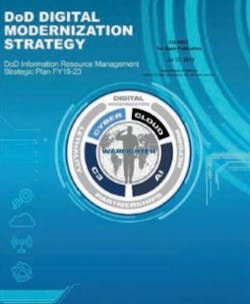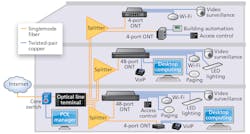Passive optical LANs: Smart buildings made simple
By John Hoover,
A passive optical LAN (POL) is by no means considered a new technology in this day and age. More than a decade ago, POLs were perceived as a niche application for secure installations in the federal space and for large multi-user environments such as hotels and residential multi-dwelling units (MDUs). But since that time, they have been deployed across a wide array of commercial enterprise environments, from schools and universities, to hospitals, financial institutions and more—a growth that has been fueled by the benefits of the technology and supported by the nonprofit Association for Passive Optical LAN (APOLAN). Comprising manufacturers, distributors, integrators and consulting companies, APOLAN has successfully advocated the education and global adoption of the technology, and recent studies show that enterprise-based POLs are on the rise.
In a 2018 study by Building Services Research and Information Association (BSRIA), the compound annual growth rate (CAGR) for the POL market was estimated at 46%, which is much higher than earlier predictions. POL also continues to gain momentum in the federal space with the U.S. government deeming it effective, efficient and secure, as confirmed by its recent inclusion in the Department of Defense (DoD) Digital Modernization Strategy for 2019 to 2023.As the Internet of Things (IoT) and advancements in the digital world like 5G, software defined networking (SDN), artificial intelligence (AI), and data analytics drive the era of smart buildings, POL is also now shaping up as a viable technology for these digitally connected workplaces of the future. Still there are those that remain skeptical about the ability of a POL to support increasing bandwidth needs, deliver Power over Ethernet (PoE) and effectively connect and manage the growing number of IoT devices that make up smart building systems. But many of these skeptics may not realize that POLs deployed a decade ago are more than keeping up with network demands, and they may not be aware of the extent to which the technology has evolved to make it deal for any commercial building.
Backed by strong roots
When POLs began making significant inroads into the commercial enterprise space, it was the early adopters that realized the benefits of the technology beyond the security, efficiency and space savings touted for federal deployments and large multi-user venues.
In 2013, following the foundation of APOLAN, the Telecommunications Industry Association (TIA) deployed a POL at its headquarters in Arlington, VA due to its environmentally friendly benefits of reduced active equipment, space and material and the ability to support fiber-to-the-desk without the need for optical fiber network interface cards (NICs) installed in end devices. While typically deployed for larger environments, TIA selected to deploy a POL at the time to create a high-tech center of information sharing and collaboration, develop a significant meeting space for collaboration on standards and public advocacy and feature the latest information and communications technology (ICT) developed by its members. The POL deployed at TIA headquarters also provided an opportunity for member companies to showcase their products. Tellabs, who donated the optical line terminal (OLT) and optical network terminals (ONTs) for TIA’s POL in memory of Rob Pullen, Tellabs’ former chief executive officer and TIA board chair, can certainly attest to that.
“We have been so incredibly appreciative to TIA over the past six years for using and showcasing our POL technology,” says Tom Parisi, vice president of federal sales for Tellabs. “Not only did our technology support TIA’s meeting spaces that enabled sub-dividable conference rooms to meet the specific needs of occupants, but it provided us with an ideal location to showcase the technology to federal and enterprise customers alike.”
Since its deployment, the POL at TIA headquarters has been used not only to support the association’s technology needs, but it also served as a demonstration of the technology and provided an optimal space for meetings and training purposes. According to Parisi, TIA’s meeting space has been used hundreds of times for these purposes, augmented by the facility’s welcoming, airy setting complete with a glass wall allowing visibility of the technology. The system also encompasses the use of intrinsic fiber monitoring technology, which has been showcased to government entities as a solution for classified environments. Ideal for any fiber links transmitting highly classified information, intrinsic fiber monitoring uses spare fibers within a fiber-optic cable that detect any manipulation or movement of the cable along the entire length of the link.“Our POL deployment has been a very positive experience for TIA, and we’ve really enjoyed having Tellabs use our space for demonstrations. When prospective users of the technology and government entities come into our facility, it elevates our reputation and allows us to showcase our commitment to emerging technologies,” says Andrew Kurtzman, vice president and general counsel for TIA. “TIA is technology-neutral and supports the growth of ubiquitous broadband including wireless, fiber and copper as network designers choose the best path to get the best outcome for their customers. The POL system at TIA’s headquarters has, however, helped us showcase innovation in the communications industry and brought us closer to a valued member company and its people.”
While TIA is now planning to move its headquarters to a smaller, more-flexible location, the reliability and performance TIA has enjoyed, may move with it as Tellabs is considering moving its equipment and service along with TIA. “It’s been a positive experience with our passive optical LAN, and the relationship we have with this technology and the APOLAN is a way to continue to honor Rob and his memory. We hope to continue showcasing technologies at our new location that are critical to the future of the communications network,” says Kurtzman.
Sustainable and smart
POL technology has long been touted as a sustainable option due to the use of passive splitters that replace active switches for energy savings and lightweight, smaller-diameter singlemode fiber-optic cable that translates to both material and pathway-space savings. Due to its already environmentally friendly benefits and recent advancements in ONT technology, POL technology is now receiving attention as a viable solution for smart buildings and the integration of IP-based converged systems, including voice, data, WiFi, distributed antenna systems (DAS), security and building automation.TIA launched its Smart Building Program in 2017 to help unify the broader ecosystem of smart buildings. With its members and real estate partners, TIA is developing a smart-buildings certification and a portal to educate and inform stakeholders on the many aspects and solutions to the smart-buildings market, including POL. In the September 2019 issue of Cabling Installation & Maintenance, in an article entitled “How passive optical LANs can support smart buildings,” Limor Schafman, senior director of TIA’s Smart Building Program, explained how POLs can simplify network management for converged systems while providing more capacity and overcoming historical distance limitations encountered with a copper horizontal plant.
The article points out the fact that singlemode fiber offers unlimited bandwidth with transmission rates limited only by the electronics themselves, providing a futureproof, sustainable infrastructure. Because POL can support distances up to 20 kilometers (12 miles), the need for data closets is drastically reduced, making it possible to eliminate many traditional telecom spaces for new construction.
“Optimal smart building experiences for occupants and operational efficiencies for building owners and managers requires data sharing, interoperable and autonomous systems,” says Schafman. “POL is a less-expensive, more-sustainable and less-space-consuming way to bring connectivity into the built environment that supports the smart building.”
Not just for greenfield
It has long been perceived that POLs make the most sense economically for new construction due to existing telecom spaces and the high cost of a full cabling infrastructure upgrade. While it remains economically sound for greenfield deployments, new advancements in POL technology now enhance the ability to leverage existing copper and multimode fiber infrastructure.
For example, Tellabs’ new FlexSym 248 Optical Network Terminal is a 1U rack-mounted 48-port ONT that offers a one-to-one traditional Ethernet switch replacement, enabling reuse of existing 100-meter horizontal balanced twisted-pair cabling from the telecom room to the outlet. With power and cable management matching a closet-based traditional switch footprint, the FlexSym 248 ONT allows for all IP-based traffic in a smart building to converge over the limitless capacity of singlemode infrastructure. With software-defined management to enable dynamically allocating functionality based on real-time needs, the FlexSym 248 Optical Network Terminal supports all enterprise Ethernet protocol requirements, including bridging VLANs, link aggregation, access control list (ACL), link layer discovery protocol (LLDP), network access control (NAC) and IEEE 802.1x port-based authentication.“It’s not always feasible to build new or fully upgrade an existing cabling infrastructure, especially when you consider the number of existing and historical buildings across all verticals—from government facilities to universities,” says Parisi. “With a 48-port ONT that can replace an existing closet-based traditional Ethernet switch, there is no need to replace the entire copper infrastructure. As upgrades are needed, the POL can be extended only to those areas where the existing copper cabling infrastructure is no longer adequate to support the technology needs.”
In addition to leveraging the existing copper infrastructure, the FlexSym 248 ONT also can reduce or eliminate HVAC in the telecom closets due to its operating temperature range of +23 deg. F to 131 deg. F (-5 deg. C to +55 deg. C), compared to most 48-port Ethernet switches with operating temperatures that typically only reach about 113 deg. F (45 deg. C).
Other options for leveraging existing cable plants include singlemode-to-multimode splitters that feature singlemode ports on the OLT side of the splitter and multimode between the splitters and ONTs. Ideal for use in campus environments where singlemode fiber is used between buildings and multimode is used within buildings, singlemode-to-multimode splitters enable reusing existing multimode riser cabling to reach ONTs mounted in telecom rooms. For existing FTTx deployments, the splitters can leverage existing horizontal multimode to reach ONTs mounted in the plenum space or at the work station.
PoE? Not a problem
The ability to remotely power end devices over copper twisted-pair cable via PoE technology is a key element in today’s intelligent buildings, eliminating the need for dedicated AC power connections that cost about 75% more to deploy and take up more pathway space. Today’s higher-power PoE capable of delivering up to 60W of power using Cisco UPoE and IEEE 802.3bt Type 3 four-pair PoE (4PPoE) and up to 90W of power using IEEE 802.3bt Type 4 4PPoE now means that more devices than ever can be powered over the network—everything from the latest high-throughput 802.11ax/ac WiFi access points, advanced security surveillance cameras and access control devices, to point-of-sale machines, LED lights, building automation systems, digital signage and even PoE-enabled desktop computers.While the ability to deliver PoE is inherent within active Ethernet copper-based networks, passive fiber-based networks have historically not supported this technology because direct current (DC) power cannot be delivered over fiber cable. But that does not mean that a POL can’t support PoE-enabled devices throughout intelligent buildings. ONTs connect to end devices using twisted-pair copper cables, and PoE can be delivered from the ONT over these cables. This can be achieved by locally powering the ONT, which is ideal for rack-mounted ONTs that reside within telecom rooms. In fact, the Tellabs FlexSym 248 ONT supports Cisco UPoE or 802.3bt 4PPoE class 5-6 to provide up to 60W on all 48 ports.
Locally powering ONTs is not the only option for PoE. For POL deployments where ONTs are located out in the horizontal space, either within ceilings, under floors or at work-area locations where local AC power is not feasible, PoE can be supported using hybrid fiber-copper cables. These cables, typically comprising singlemode fiber for data transmission and two 12-, 16-, or 18-AWG copper conductors for power, provide a simple, elegant solution for delivering DC power from a central power supply to the ONT, eliminating the need for local AC power. This approach not only enables ONTs to deliver PoE to end devices, but it also enables the POL to leverage the same centralized power with generator or battery backup used in copper-based networks to avoid downtime in the event of a power failure.
“Twisted-pair Category 6 or higher copper cables used in traditional Ethernet active networks are limited to 100-meter lengths, and depending on the level of PoE, they may need to be length-derated due to heat rise and associated insertion loss that can degrade network performance,” explains Parisi. “The distance to end devices is not only limited by copper cabling standards, but it is also directly related to the gauge of the copper conductors—larger conductors can carry more DC power over longer distances. Hybrid fiber-copper cables with larger-gauge copper conductors can deliver DC power further than much smaller gauge Category 6 and Category 6A copper cables, allowing POLs to enable longer link lengths even when delivering PoE to end devices, resulting in more flexible, cost-effective deployments.”
Bringing it all together
With a POL’s ability to support bandwidth, sustainability, security, distance and remote power, as well as leverage existing copper infrastructure, it is clearly well suited as a scalable, flexible and future-ready solution for the thousands of IoT devices now connecting to the network. And when it comes to managing it all, a POL with centralized, software-defined management offers significant benefits over traditional active Ethernet networks.
Reports by Allied Market Research predict the global smart building market to surpass $35 billion in 2020, and Happiest Minds predicts nearly 20% of U.S. commercial buildings to be smart within the next year. The trend is expected to only increase, and the ever-increasing number of connected devices means that traditional active networks are faced with more ports to manage, more power consumption and associated thermal management—not to mention an increasing number of cables with more plastics and PVC materials in walls and ceilings. In other words, with IoT and intelligent buildings, traditional networks ironically increase complexity and labor and material cost, while adversely impacting the sustainability and environmental advantages that intelligent buildings are supposed to enable.
In a POL, ONTs are centrally managed via the OLT and POL manager, regardless of whether they are located 300 feet or 30,000 feet from the OLT. That’s because ONTs do not store network or user information, but are fully controlled by the OLT and PON manager, allowing network managers to define bandwidth, authorization, quality of service (QoS), security, VLANs, traffic and PoE from one location.“The OLT is essentially one large switch with nothing to manage in between the OLT and the end devices,” says Parisi. “With plug-and-play deployment and centralized software-defined management via the OLT, a POL can enable better security, fortified procedures and policies, and faster moves, adds and changes. And that’s critical with IoT, thousands of end devices and the current IT skills gap we are seeing in the ICT industry.”
With long-standing performance and new advancements in the technology, combined with centralized management that will reduce complexity for the smart buildings market—and all backed by an industry association dedicated to the technology with APOLAN—it’s evident that the future of POLs, and the smart buildings they will support, are looking brighter than ever.
“Passive optical technology simply makes sense for a range of LAN environments, just as it has in residential FTTx, hospitality and government deployments,” says David Stehlin, CEO of TIA. “Pushing fiber deeper into networks of all types supports the need for more and flexible bandwidth that comes with the latest technological advancements in the era of IoT and smart buildings.”
John Hoover is senior product manager at Tellabs and a board director for the Association for Passive Optical LAN (APOLAN).






